1.2 A consistent approach to finishes
SCOPE
Introduction
A consistent approach to finishes gives guidance on the suitability of the finishes in new homes and will be used by NHBC Inspectors during the construction of new homes and by NHBC Claims staff conducting Resolutions under Section 2 of the Buildmark insurance cover. Its recommendations will be considered in conjunction with relevant performance standards and guidance of the NHBC Standards.
The guide is intended to apply at the time the home is physically complete and has passed its NHBC pre-handover inspection. However, some elements may be subject to thermal or drying movement and this may occur both before and after completion. Where appropriate, guidance is given as to the likely changes which may occur during this period.
Many sources of information relating to tolerances have been reviewed in the preparation of the guide. The tolerances given here are considered to be appropriate for the house-building industry and take precedence over other recommendations.
This guide is not intended to deal with every situation that may arise and discretion should be exercised in its application in specific circumstances. The nature and extent of work necessary to remedy minor variances from the tolerances given should be appropriate to the circumstances.
EXTERNAL WALLS
The variable nature of external wall materials and their use
Many of the materials used to construct external walls are not uniform, because of their manufacturing process. Nor are they intended to be. In consequence, external walls will have variations and irregularities. Where reclaimed materials are used there may be even greater irregularities and these characteristics are often intended as an aesthetic feature. The relevant recommendations are intended to be applied in the spirit of this overall context.
Commentary
- Bricks and other materials vary in size and appearance for a number of reasons and in consequence the tolerances and finishes stated in this document may not always be appropriate, especially where reclaimed stock is used. Such materials will need to be considered separately.
- The tolerances described generally apply to entire areas of walling, complete panels and the like, and not to the elements of the construction, such as individual bricks.
- The tolerances do not apply to design features and similar constructional details which are not intended to lie within the limits stated in this document (e.g. quoins, soldier courses, plinths).
FAIRFACED BRICKWORK AND BLOCKWORK
Straightness on plan
±10mm max deviation in any length of wall up to 5m.
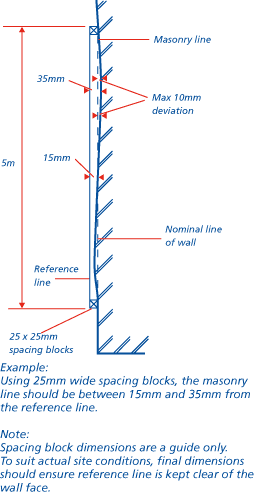
Level of bed joints
± 10mm deviation for walls 5m long (a pro rata tolerance is applicable for walls less than 5m long).
± 15mm deviation for walls over 5m long.
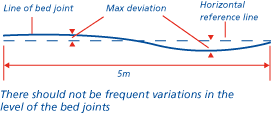
Thickness of bed joints
The thickness of an individual bed joint should not vary from the average of any 8 successive joints by more than 5mm.
Commentary
- Bricks and other materials vary in size and therefore some variation in the thickness of bed joints is likely.
Perpend alignment in external walls
Vertical alignment of perpend joints should not deviate significantly from the perpendicular.
Commentary
- Because bricks do vary in length as a result of their manufacturing process, not all perpend joints will align. However, there should not be a cumulative displacement of the perpend joints in a wall.
Plumb of wall - overall height
Max deviation of ± 20mm in overall height of wall.
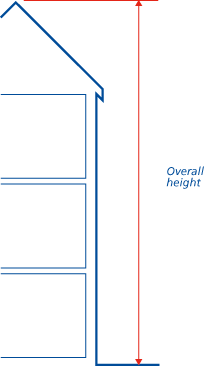
Plumb of wall - storey height
Max deviation of ± 10mm in a storey height, approx 2.5m.

Straightness in section
Max deviation ± 10mm in any 2.5m height of wall.
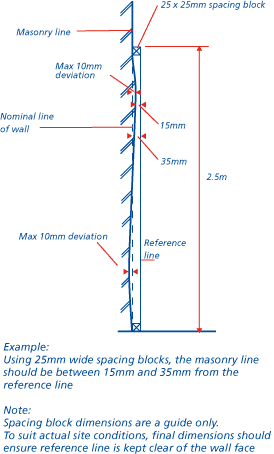
Straightness of external reveals
6mm max deviation.
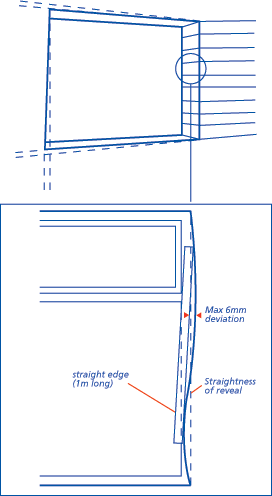
RENDERING (PLAIN FINISH)
Vertical and horizontal flatness
± 10mm (excluding features)
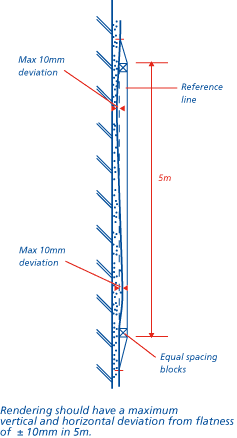
Commentary
- Features such as bell casts, and the areas of render in close proximity to the feature, are excluded from the tolerance .
- Flatness is measured in a similar way to straightness on plan and plumb of masonry.
Appearance of external wall finishes
Fairfaced brickwork and blockwork
Fairfaced brickwork and blockwork should be reasonably uniform in appearance, texture and finish.
With certain walls, such as half brick walls, a fairfaced finish can only be achieved on one face. The other face should be left neat and tidy.
Mortar should be reasonably uniform in appearance, texture and finish.
Facing brick units should not have significant cracks in them or other damage such as chips and marks greater than 15mm in diameter.
Commentary
- Appearance should be considered for entire wall areas, panels and the like and not for individual units. Consequently, the wall being considered should, where possible, be viewed in daylight from a distance of 10m.
- Some mortar blemishes will occur on individual masonry units.
- Some variation will occur in the colour of individual masonry units and generally over the wall.
- Some variation will occur in the appearance, texture and finish of mortar.
- Efflorescence occurs naturally in some types of masonry. It is not harmful and usually disappears over time.
- Some brick products have natural or design features which may be in excess of 15mm in diameter.
- Some minor shrinkage cracking may occur between masonry units (bricks and blocks) and mortar joints.
Rendering
Rendering on walls should be reasonably consistent in texture, finish and colour.
Commentary
- Rendering should, where possible, be viewed in natural daylight from a distance of 10m.
- Some minor cracking and crazing is likely to occur but should not be such as to affect its performance.
- Some patches and daywork joints may be visible but should not be unduly obtrusive.
Tile hanging
Panels of tile hanging should be reasonably uniform in appearance, particularly at abutments.
Commentary
- Tile hanging should, where possible, be viewed in natural daylight from a distance of 10m.
- Certain handmade tiles vary in size and may not be of a uniform appearance.
- Some variation in colour may occur in tiles.
External Works
Drives and paths - standing water
Surfaces should minimise the potential for standing water.
Commentary
- One hour after rain has stopped, isolated areas of temporary standing water up to 1m2 and no deeper than 7mm are considered to be reasonable.
Drives and paths - variations in surface finish
Variations in the surface should not exceed ±10mm deviation from a 2m straight edge with equal offsets.
Commentary
- Some minor variations in surface levels including scuffing and pitting may arise due to settlement, natural ground movement and vehicle use. In gravel and other loose surfaces, displacement of stone etc., will require some maintenance by the homeowner.
- Localised falls into gulleys and channels are acceptable.
Covers to the drainage system
Covers to the drainage system in hard paved areas should align with the adjacent ground.
Commentary
- In hard landscaping, some settlement of the area immediately around the cover is to be expected. The difference in height between a cover and the adjacent hard surfaces should be not more than 10mm.
- In soft landscaping, such as lawned areas, some settlement of the ground may occur and would be made good by the homeowner as part of normal household maintenance.
Doors and windows
Openings in walls (including external openings viewed from the inside)
Reveals, head and sill
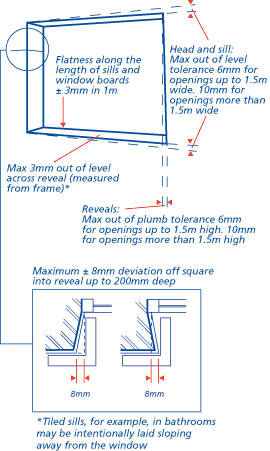
Gaps and distortion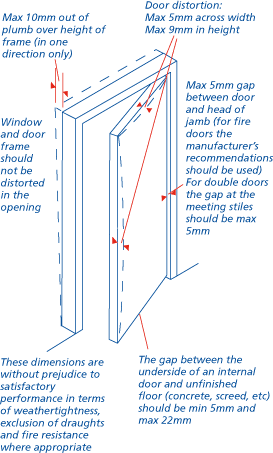
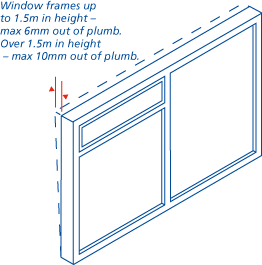
GLAZING
When viewed in daylight from within the room and at least 2m from the panes (3m for toughened, laminated or coated glass) and looking at right angles through the glass, the following are acceptable if they are neither obtrusive nor bunched:
- bubbles or blisters
- hairlines or blobs
- fine scratches not more than 25mm long
- minute particles
Commentary
- The above does not apply within 6mm of the edge of the pane, where minor scratching is acceptable.
WALLS AND CEILINGS (PLASTERED AND DRY LINED)
Wall and ceiling surfaces
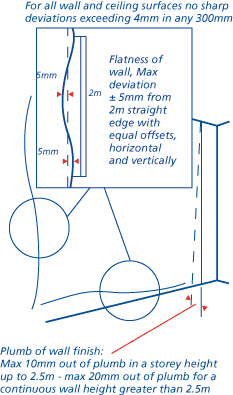
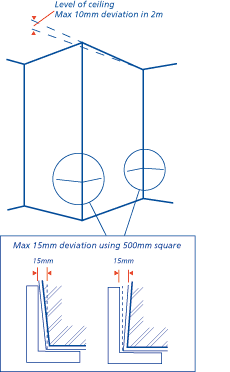
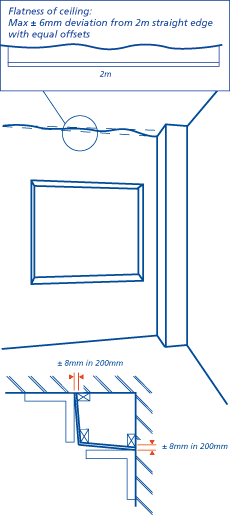
Surfaces should be reasonably uniform although there may be minor textural differences around lights and other fittings. There should be no visible gaps between fittings and the wall/ceiling, e.g. around switch plates.
In plastered walls and ceilings some tooling marks may be visible.
In general wall surfaces, some cracking (up to 2mm wide is likely, due to shrinkage and differential movement of materials and should be made good by the homeowner as part of normal household maintenance.
Junctions
At wall, floor and ceiling junctions where there are changes in the construction materials used, small cracks (up to 2mm wide) may appear in the surface as a result of shrinkage and differential movement of materials.
Duct casings
Duct casings, access covers and any associated framing should be neat and tidy and have an appropriate decorative finish.
Skirtings
Joints in skirtings are likely in long lengths of walls. Joints should present a continuous appearance when viewed from a distance of 2m in daylight. Some initial shrinkage of the skirting may already be evident at completion of the property.
Gaps in skirtings may appear at joints and corners due to shrinkage and should be made good by the homeowner as part of normal household maintenance.
Blockwork walls in garages
Normal drying out shrinkage may lead to cracking of unplastered blockwork walls. Thermal movement and drying shrinkage may become evident but cracks of up to 3mm are generally considered to be normal.
Commentary
- Small cracks may occur in wall finishes which pass across floors e.g. in walls adjacent to a staircase
- Where stair strings abut a wall a crack of up to 4mm may appear as a result of shrinkage of materials and should be made good by the homeowner as part of normal household maintenance.
FLOORS
Level of floor
Maximum 4mm out of level per metre for floors up to 6m across, and maximum 25mm overall in any other case.
Flatness of floor
Maximum ± 5mm deviation from a 2m straight edge with equal offsets
Skirting to floor gap
A gap of up to 5mm can be expected between the floor finish (without coverings) and the bottom of the skirting in a newly completed home.
The gap between the floor finish and the skirting may increase because of drying out shrinkage and deflection, particularly in timber floors. A gap of up to 10mm is normal but exceptionally 15mm may be seen where timber floors have long spans or there are heavy items of furniture on the floor.
Floor screeds
As screeds dry, they may shrink causing minor cracking which requires no remedial action.
Underfloor service ducts
Service ducts should be constructed so that the cover is level on completion with the adjacent floor finish provided by the builder
Commentary
Drying shrinkage of the floor may result in minor differences in level between the floor and duct cover. This may become evident with some types of thin floor coverings, and the choice of covering should take this into account.
Timber floors and staircases
Timber floors and staircases are made of materials which naturally shrink as they dry. As this drying occurs, it may result in squeaking of components as they move against each other. This is natural and to be expected. Some squeaking is to be expected and cannot be totally eliminated.
FINISHES AND FITTINGS
Painted and varnished surfaces
Surfaces should be reasonably smooth and free from nail holes, cracks and splits. Joints should be filled. Colour, texture and finish should be reasonably uniform.
Commentary
- Surfaces should be viewed in daylight from a distance of 2m and not by shining artificial light along the surface. Wall lights or uplighters should be switched off.
- Painted and varnished surfaces should be free from conspicuous runs and prominent brush marks. There should be no bare or starved areas.
- Timber surfaces may show limited raised grain and the colour and texture may also vary.
- Drying shrinkage of timber may cause cracking of the paint finish particularly where joints occur in plaster and woodwork and should be made good by the homeowner as part of normal household maintenance.
- Where painted surfaces are touched-up, minor colour variations will occur.
- External finishes will dull over time depending on a number of factors such as exposure to sunlight, rain and pollutants. To minimise the dulling, surfaces should be washed regularly to remove the accumulation of dirt and grime.
Knots in timber
Some exudation of resin from knots may occur and may cause discolouration of paintwork, both internally and externally.
Commentary
Because timber is a natural material some resin is likely to exude from knots even though modern primers contain a knotting compound to limit the effect.
Fitted furniture (kitchen, bathroom and bedroom)
Doors and drawers of fitted furniture should be visually aligned vertically, horizontally and in plan, and operate as intended by the manufacturer.
Gaps between adjacent doors and/or drawers should be uniform.
There should not be a significant difference in level at the intersection of adjacent worktops.
Commentary
- No dimensional tolerance has been set for gaps between adjacent doors and/or drawers or for their alignment because some variation will be necessary to take account of adjustments as part of the fitting process. Over time door and drawers may need some adjustment by the homeowner as part of normal household maintenance.
- No dimensional tolerance has been set for the abutment of adjacent worktops because of the variety of materials available and because minor variations, even with manufactured products, are inevitable and small differences in height may be unavoidable.
- Fitted furniture should normally be viewed from a distance of 2m.
Scratches on doors (including fitted furniture), windows and frames
Factory-finished door and window components should not have conspicuous abrasions or scratches when viewed in daylight from a distance of 0.5m.
Commentary
- Conspicuous surface abrasions caused during the building-in process should be removed in accordance with the manufacturer's recommendations which may include polishing out, re-spraying or painting as appropriate.
- In rooms or areas when there is no daylight, scratches should be viewed in artificial light from fixed wall or ceiling outlets and not from portable equipment.





















